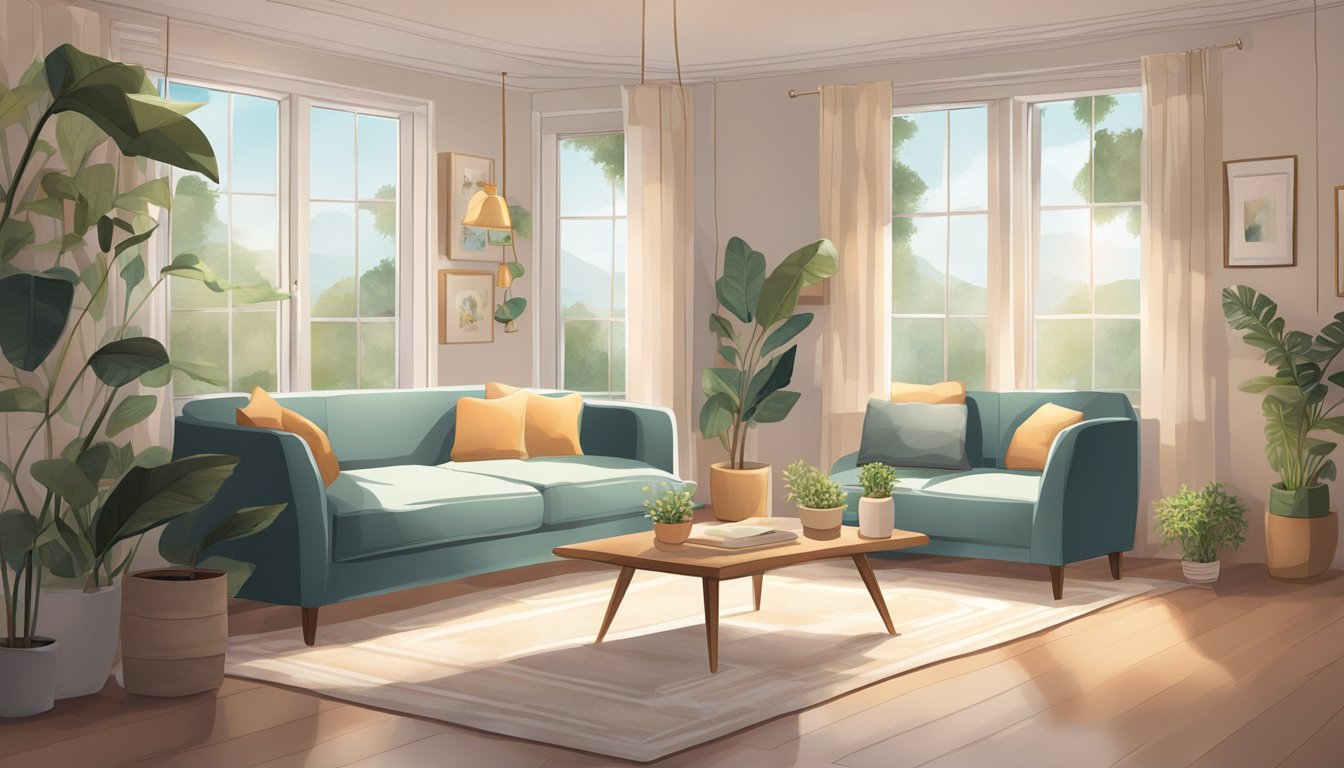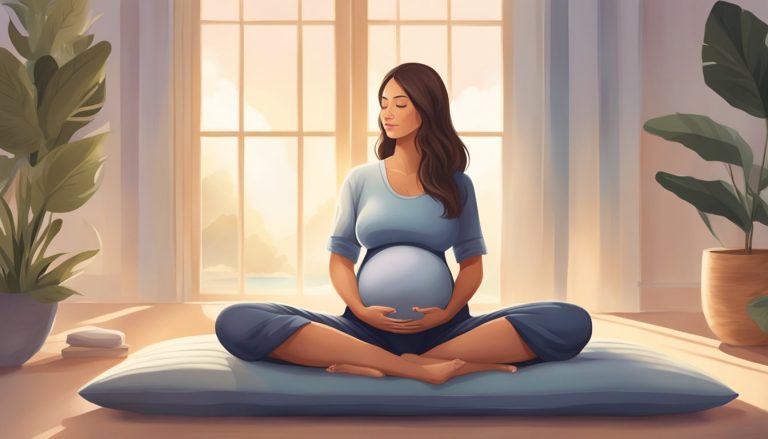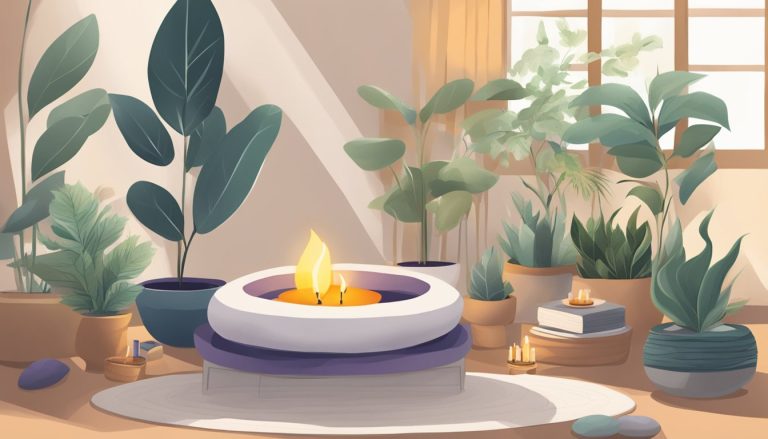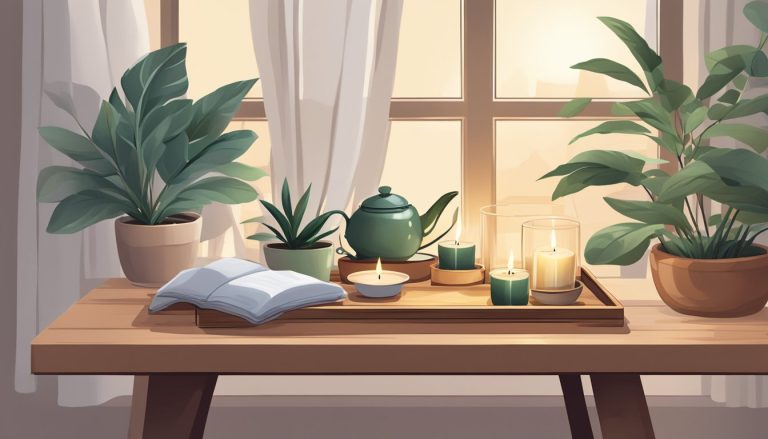How Do You Make a Safe Space for Meditation?: Essential Tips for a Tranquil Retreat
Creating a personal safe space for meditation involves conscious choices and intentionality.
By carving out a quiet corner in my home, I allow myself the opportunity to retreat into a state of calm and introspection.
Ensuring this space is imbued with a sense of tranquillity and privacy aids in kick-starting a meditative practice, where I can focus on relaxation and mindfulness.
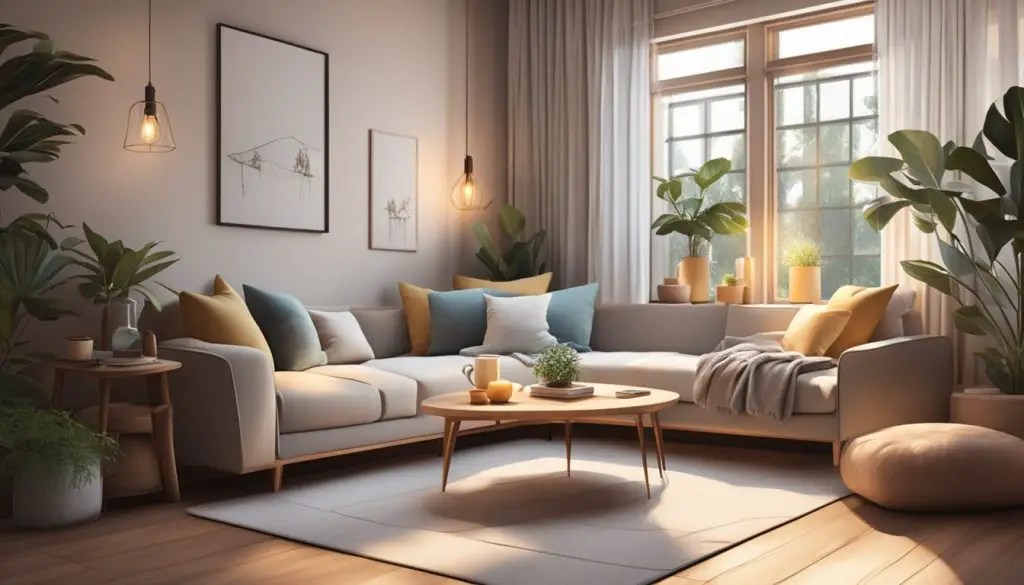
Essential elements like a comfortable seating position, minimalistic decor, and soothing colours set the stage for a successful meditation journey.
As I regularly dedicate time to sit in this space, I find it becomes a sanctuary where stress dissipates and peace flourishes. This evolving process of creating and maintaining a meditation space becomes a cornerstone of my daily routine.
Key Points
- Meditation spaces should promote calmness and mindfulness.
- Essential elements for meditation include comfort and minimal distractions.
- Regular practice enriches the tranquillity of the space and my well-being.
Table of Contents
Step 1: Creating Your Meditation Space
In setting up my dedicated meditation space at home, I focus on creating an environment that fosters tranquillity and minimal distractions. I’ve found this promotes a deeper focus during my quiet time.
Choosing the Right Location
I look for a private corner or area in my home that allows for both silence and solitude. An ideal spot could be a seldom-used part of my living room, a peaceful corner of my bedroom, or even a dedicated section of my home office.
If possible, a space with a view of nature from a window can enhance the peacefulness of the environment.
Minimising Distractions
To ensure my meditation space is free from interruptions, I communicate with my household about my need for uninterrupted time.
Clutter is a big no-no, so I make the effort to keep the space tidy and remove any unnecessary items.
I also switch off my phone and other electronic devices to maintain the sanctity of the space.
Incorporating Natural Elements
I integrate elements of nature into my meditation space to bring a sense of calm and grounding. This includes:
- Natural Light: Positioning my space to maximise exposure to sunlight.
- Plants and Flowers: Adding potted plants or fresh flowers to cleanse the air and bring life to the space.
- Crystals: Strategically placing crystals that are said to aid in meditation.
Design and Aesthetics
My meditation space design is simplistic and purposeful, reflecting a minimalist approach that aligns with the sacred nature of the area. I prefer to use:
- Colours: Calming colours like soft blues and greens.
- Sacred Items: An altar or shelf for symbolic items that resonate with me personally.
Selecting Meditation Props
To support my body during meditation sessions, I choose:
- Cushions and Mats: Investing in a quality meditation cushion or yoga mat for comfort.
- Pillows and Blankets: Including soft pillows and blankets for additional support.
Setting the Atmosphere
Finally, I set the atmosphere of my meditation space to be inviting and serene. This involves:
- Scent: Using candles, essential oils, or incense to create a suitable olfactory backdrop.
- Sound: Introducing subtle background music or soundscapes that aid concentration. If I prefer silence, I might use a singing bowl or bell to mark the beginning and end of my practice.
Step 2: Meditation Essentials
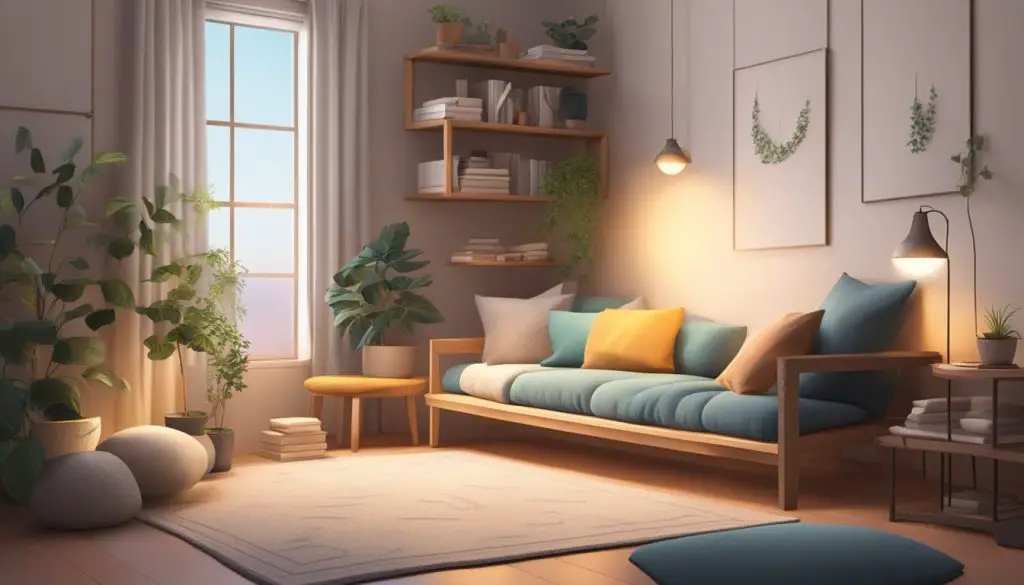
In ensuring that my meditation sessions are as effective and comfortable as possible, I pay special attention to a few essentials that set the stage for an enriching practice.
Choosing Comfortable Attire
For me, comfort is key during meditation, so I choose attire that allows freedom of movement and breath. Comfy clothes such as loose-fitting trousers and a soft shirt make a world of difference.
I make sure that my clothes don’t distract me by being too tight, itchy, or restrictive.
Meditation Accessories
Having the right accessories can greatly enhance my practice. Here’s a list of items I find useful:
- Cushions: To support my posture and provide comfort.
- Mala Beads: They help maintain focus on my breath and intention during practice.
- Journal: For reflecting on my thoughts before or after meditation.
- Crystals: Some find that they add an element of calm and clarity.
- Books: Occasionally inspiring my meditation with a reading beforehand.
I like to keep my senses engaged during meditation, which sometimes involves the subtle use of incense or a scented candle for a pleasant aroma that doesn’t overwhelm.
Preparing for Meditation Practice
Preparation is a ritual in itself. Before I sit down, I ensure all potential distractions are minimised. My phone is on silent, and I’ve informed others that I require some time undisturbed.
I take a few moments to set an intention for my session, allowing me to enter a state of stillness with a clear focus.
Taking several deliberate, deep breaths, I transition smoothly into my meditation, allowing the practice to bring me a profound sense of peace and clarity.
Step 3: Incorporating Mindfulness and Focus
In this section, I’m going to show you how to harness mindfulness and focus to make your meditation practice more effective. I’ll cover techniques that enhance concentration, explain the importance of stillness and silence, and guide you through body and breath awareness for a more grounded experience.
Techniques for Enhanced Concentration
To strengthen my concentration, I find it helpful to designate a focal point for my attention.
Breathing is a natural and effective choice. I’ll start by taking slow, deep breaths and paying close attention to the cycle of air moving in and out of my body.
This acts as a grounding technique, pulling my mind away from distractions.
I also sometimes use mantras, which are short, positive phrases that I repeat to maintain focus and clarity.
Another effective strategy is to count breaths, which provides a simple and rhythmic pattern that helps to sharpen concentration.
Embracing Stillness and Silence
Stillness and silence are my allies in creating a safe meditation space. In a world filled with constant noise, finding a quiet spot is vital for relaxation and focus.
I make sure to sit in a comfortable position and encourage my body to relax. I pay attention to the silence around me, letting it envelop me and create a protective barrier against the chaos of the outside world.
Embracing this stillness allows my mind to settle and provides me with a sense of inner peace that enhances mindfulness.
Body and Breath Awareness
I anchor my meditation practice into body and breath awareness, where I observe the sensations within my body and the rhythm of my breath.
I take the time to notice any areas of tension and consciously invite those muscles to relax.
As I breathe in and out, I can sometimes experience the breath as a wave—flowing through me, bringing relaxation and easing any remaining tension.
I constantly bring my attention back to my body and breath, which helps me stay present and connected with the moment.
This practice of body awareness not only deepens relaxation but also acts as a foundation for building mindfulness.
Step 4: Enhancing Your Experience
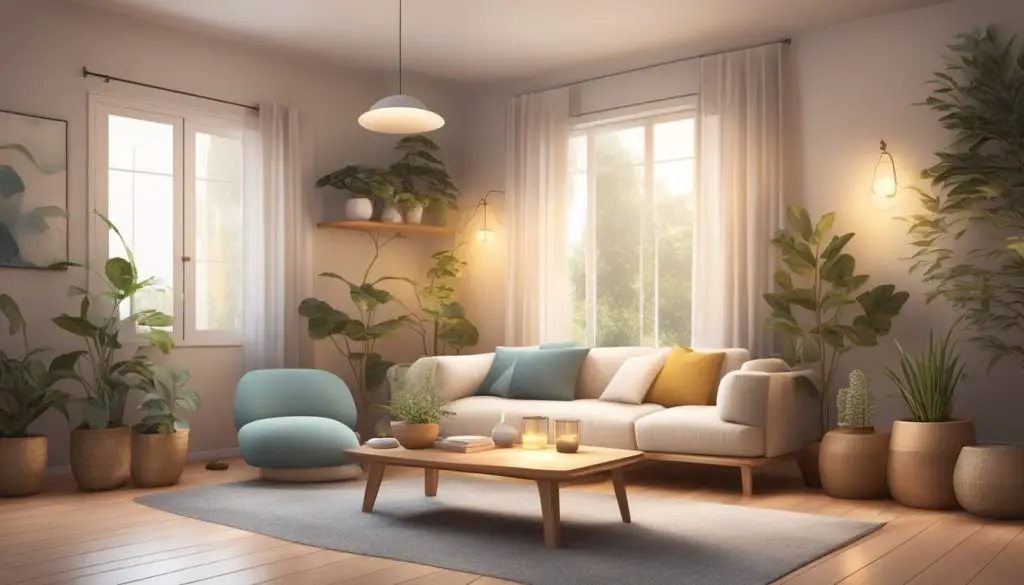
In creating my meditation space, I have found that the key to deepening the practice lies in tailoring the environment to stimulate the senses and set a clear, focused intention. This is not just about the physical place but also about engaging with elements that make the space truly sacred for me.
Rituals and Symbols
I often start my practice with a small ritual to signal to my mind that it’s time to transition into a meditative state. I might light candles or strike a singing bowl to fill the space with reverberating sound.
Incorporating symbols like a Buddha statue on a shelf or an altar can serve as powerful visual cues that reinforce my intention.
- Rituals to Start Meditative Practice:
- Light candles or incense
- Use a singing bowl or bell
- Arrange sacred objects on an altar
Leveraging Audio and Visual Elements
The auditory and visual elements in my meditation space are crucial for enhancing the experience.
I sometimes play soft music through speakers or use headphones to listen to nature sounds, which helps me focus and keeps external noise at a minimum.
A diffuser with essential oils scents the air lightly, providing a soothing backdrop that engages my sense of smell.
- Audio Elements:
- Soft ambient music
- Nature sounds
- Visual Elements:
- Dimmed lighting or coloured lights
- Visual focus points such as statues or nature elements
The Role of Guided Meditation
Guided meditation has been an invaluable tool, especially on days when directing my own practice feels challenging. Whether it’s a recording from a respected teacher or a session via an app, these guided experiences offer structure and can be a potent source of learning new techniques.
I ensure my device is charged and I have a comfortable set of headphones to make the most of this resource.
- Utilising Guided Meditation:
- Select meditations that align with your intentions
- Use comfortable headphones to stay immersed
Step 5: Maintaining a Dedicated Practice
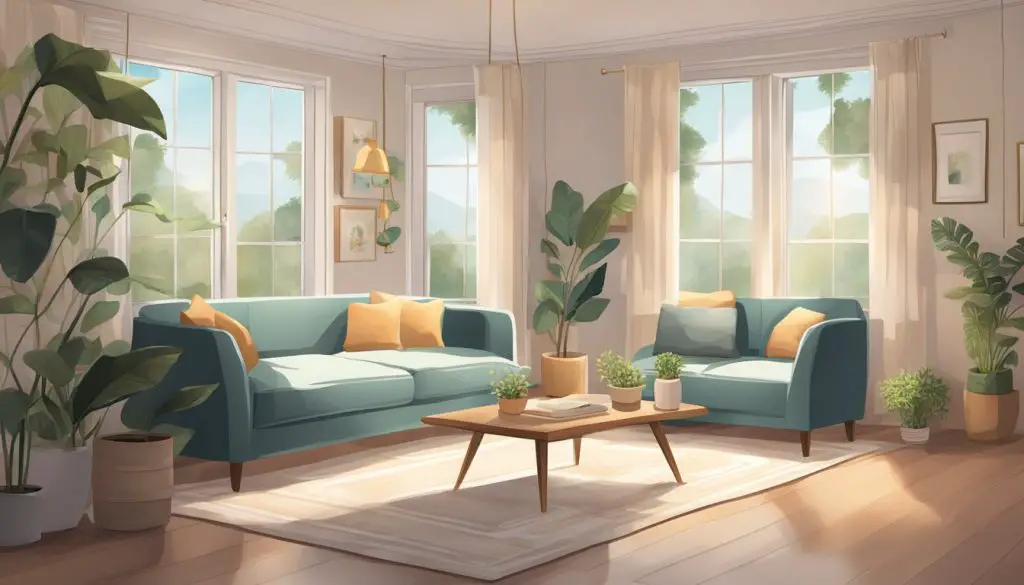
In my journey to maintain a regular meditation practice, I’ve found that consistency is key, and overcoming challenges can be managed with the right strategies. I’m continuously learning and adapting my sanctuary to support my daily meditation ritual.
Creating a Consistent Routine
To build my practice into a non-negotiable habit, I’ve established a daily meditation ritual.
Every morning, I designate 10-15 minutes in my sanctuary, ensuring it becomes as regular as brushing my teeth.
- Time: My alarm is set for the same time each morning to avoid procrastination.
- Location: I always sit in my dedicated space, a retreat that calmly waits for me.
- Intention: Before I begin, I set my intention to bring purpose to my session.
Dealing With Challenges
I tackle stress, anxiety, and emotion head-on by turning to my practice.
When distractions arise, I acknowledge them without judgement and gently bring my focus back to my breath or mantra.
If I ever feel fear or discomfort, I remind myself that these feelings are just as much a part of the process as the tranquillity I seek.
- Strategies:
- Short Breaks: When overwhelmed, I’ll take a few deep breaths to centre myself.
- Acceptance: Accepting that challenges are a natural part of practice reduces my internal resistance.
Continuous Learning and Adaptation
My meditation journey within Western culture is enriched by continuous learning.
I often seek guidance from books, teachers, and even guided meditations, which all contribute to deepening my understanding and helping me adapt my practice as needed.
- Resources:
- Books: The Art of Mindfulness sits on my shelf for quick reference.
- People: Chatting with a teacher when I can, gives me new perspectives.
- Online: Guided sessions offer variety and support my learning curve.
Conclusion

Creating my personal meditation space has been a delightful journey towards enhancing my well-being. I’ve noticed that the sense of serenity I achieve during meditation extends beyond my sessions, contributing to a lasting inner calm.
It’s become clear that the benefits of a dedicated space—a corner of tranquillity in my own home—include a deeper focus and a more profound connection with my practice.
Benefits to Well-being:
- Improved focus
- Deepened meditation experience
- Sustained feelings of peace
My space doesn’t need to be large or lavishly decorated; it’s the intention behind it that truly matters. A simple candle or a comfortable cushion can make all the difference.
By associating my meditation corner with stillness and peace, I encourage a serene feeling every time I enter the space.
Elements Conducive to Serenity:
- Soft lighting or candles
- Comfortable seating
- Minimal distractions
The integration of this sacred space into my daily routine reinforces a proactive approach to mental health. By prioritising meditation, I invest in my well-being. The impacts—emotional balance, mental clarity, and stress reduction—are well worth the effort.
My advice is to keep the space welcoming, use it regularly, and cherish the serenity it brings to life.
Frequently Asked Questions
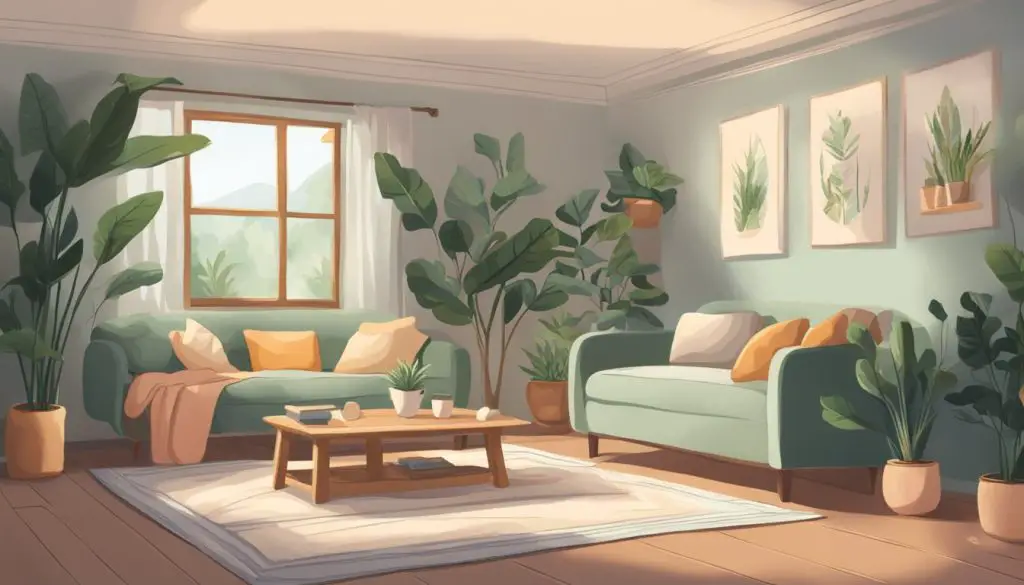
Creating a personal meditation space at home can be a tranquil experience. I’ve put together some practical advice to help answer common questions related to establishing such a space.
What steps are necessary to set up a personal meditation area at home?
I find that the key steps include selecting a quiet corner of my home and ensuring it is clean and free from clutter. It should be a space where I can feel at peace.
I also like adding elements that induce calmness, such as soft colours, comfortable cushions, and perhaps a scented candle or two.
Can you offer guidance on safe space imagery exercises that can enhance meditation experiences?
Certainly. Imagery exercises involve visualising a peaceful scene or sanctuary in my mind.
I use descriptive details like the sound of waves or the warmth of the sun to deepen my sense of relaxation and safety during meditation.
In what ways can one personalise a meditation space to reflect individual tranquillity?
I personalise my meditation space with items that have personal significance, such as photos of loved ones, a treasured keepsake, or plants that I find beautiful.
This makes the space uniquely mine and more conducive to tranquillity.
What characteristics define a space as ‘safe’ for the purposes of meditation and reflection?
A ‘safe’ space for me is one where I feel secure, at ease, and free from interruptions. It is private, comfortable, and set up in a way that reflects my taste and promotes a relaxed state of mind.
How might someone adapt common household areas into a dedicated zone for peaceful contemplation?
I sometimes adapt spaces like a quiet corner of my living room or bedroom, ensuring I can maintain privacy.
I rearrange furniture to create a small, clear area and add dividers like curtains or screens for a more secluded atmosphere.
What are some effective strategies to facilitate a respectful and soothing environment for group discussions?
To create a respectful and soothing environment for group discussions, I ensure that the space is arranged so everyone can see and hear each other well.
Soft lighting, comfortable seating, and perhaps some gentle background music can make the atmosphere more conducive to calm and thoughtful discussion.

